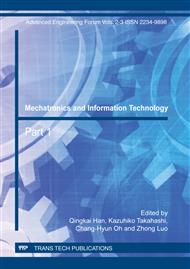p.330
p.334
p.340
p.346
p.352
p.358
p.362
p.366
p.372
A Tolerance Analysis Approach Based on Robot Kinematics
Abstract:
This paper presents a tolerance modeling approach based on robot kinematics theory within CAD/CAM system. Based on the differential kinematics theories, each feature of characteristics including size tolerance and geometrical tolerance was established as a corresponding small displacement torsor. In order to express the relation between the small displacement of all functional features and the functional requirement, the final expression was represented to establish the projection of analysis of the tolerance chain. A mathematical expression was obtained by the mean instead of single points, and the constraints can be represented by interval using the standard deviation, not limit deviations. After having identified the unit components and the functional requirement from the tolerance chain, we obtained the percentage contribution of each unit feature to the functional requirement. A percentage contribution can help designer to decide which tolerance is tighten or loosen. The application of the tolerance analysis approach in a simple three-dimensional sample was also discussed in this paper.
Info:
Periodical:
Pages:
352-357
Citation:
Online since:
December 2011
Authors:
Permissions:
Share:
Citation:


